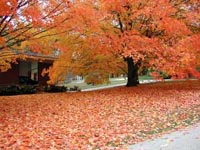Resource Library
Plant of the Week: Sugar Maple (Hard Maple)
The University of Arkansas System Division of Agriculture does not promote, support or recommend plants featured in "Plant of the Week." Please consult your local Extension office for plants suitable for your region.
Plant of the Week
Sugar Maple, Hard Maple
Latin: Acer saccharum

It’s official - Mundare, Alberta won! During the summer, I was fortunate enough to serve as a judge in the Communities In Bloom program that tallies quality of life characteristics of communities across Canada. My partner and I visited 11 communities in seven provinces, all with fewer than 1,000 people, where we were shown what pride, people and plants can do to make even the smallest communities better places to live. While the sugar maple, Acer saccharum, is not well adapted to the cold, flat prairies surrounding Mundare in western Canada, it's no doubt the most recognizable plant symbol for our neighbors to the north.
The sugar or hard maple is a big tree capable of reaching 100 feet with a spread half its height. Its native range includes all of the eastern woodlands from the southeastern corner of Manitoba to the Ozarks in northern Arkansas and east to the southern Appalachians in northern Georgia. The sugar maple look-alikes of the Ouachitas in southwestern Arkansas are the chalk or Florida maple, depending on the taxonomic treatment used to define the species.
The sugar maple leaf is easily recognizable as the stylized, three-lobed leaf on the Canadian flag. The flag is of relatively recent vintage, having only been adopted in 1965 when Prime Minister Lester Pearson encouraged the Canadian legislature to develop a new flag as a symbol of national unity as the centennial of the Federation approached in 1967.
No other tree better symbolizes the arrival of fall than the reds, oranges and yellows of sugar maples, as countless busloads of New England tourists can attest.
The Communities In Blooms program is in its ninth year, beginning as the brainchild of Raymond Carriere, a parks director in suburban Montreal. Communities first compete at the provincial level with winners then able to go on for competition for national bragging rights. The program categorizes communities in a dozen different sizes based on population.
Eight different criteria are used for evaluation, with 60 percent of the points coming from beautification kinds of considerations while the remaining points come from community related issues such as volunteerism, recycling efforts and other environmental issues. Scenic beauty is not a part of the evaluation criteria, so quaint fishing villages on the coast have no advantage in scoring over small communities on the windswept prairies.
Visiting these communities was an eye-opening experience. Small towns everywhere are having a difficult time maintaining population. Children grow up and move to the city, as much for the perceived life style advantages as for employment.
To remain viable, communities have to create the kind of atmosphere that makes the decision to move away a difficult choice. By involving people of all ages in the clean up, fix up, pretty up campaigns that are a part of all successful CIB programs, residents become stakeholders in their communities.
Because these small towns don’t have the resources to hire staff, volunteers are the backbone of everything from litter control to watering the hanging baskets on Main Street. While beautification alone can’t solve the economic issues challenging small communities, it can provide a rallying point to bring the community together to address the larger concerns.
The CIB program was imported to the United States in 2002 where it is known as America In Bloom. The goals and guidelines for participation are adapted from the Canadian program. Fayetteville was one of the three dozen communities that participated in the AIB program in its first year, going on to win against the two other cities competing in its size category. This year, it competed in the International Challenge, going up against communities in Canada and Great Britain.
But, back to the sugar maple. It's well adapted in most of Arkansas with the exception of the Delta region and the southernmost counties. Sugar maples are slower growing trees than the red or silver maple, so be patient. This slower growth makes the tree a longer lived specimen in the landscape and one that will, given time, be a beautiful addition to the fall landscape. Trees usually don’t start showing good fall color development until they reach sexual maturity, which usually takes about 20 years.
By: Gerald Klingaman, retired
Extension Horticulturist - Ornamentals
Extension News - October 3, 2003
The University of Arkansas System Division of Agriculture does not maintain lists of retail outlets where these plants can be purchased. Please check your local nursery or other retail outlets to ask about the availability of these plants for your growing area.